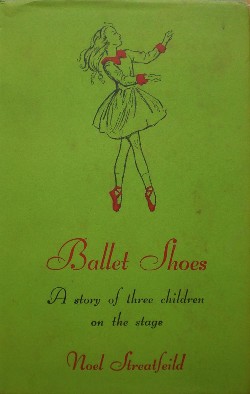Plot summary
The book concerns three adopted sisters, Pauline, Petrova and Posy Fossil. Each of the girls is discovered as a baby by Matthew Brown (Great-Uncle-Matthew, known as "Gum"), an elderly, absentminded palaeontologist and professor, during his world travels, and sent home to his practical great niece, Sylvia, and her childhood nanny Nana who live in London, England.
Gum embarks upon an expedition of many years and arranges for money to support the family while he is gone. Gum does not return in the promised five years and the money is almost gone. As they have no way to contact or track him down, Sylvia and Nana take in boarders to make ends meet, including Mr. Simpson and his wife, Dr. Jakes and Dr. Smith, a pair of tutors who take over the children's education after Sylvia can no longer afford their school fees. Boarder Theo Dane, a dance teacher, arranges for the children to begin classes at the Children's Academy of Dancing and Stage Training.
Pauline finds she has a talent and passion for acting while Petrova hates acting and dancing. Posy has a real talent for dancing. When she is about six, Madame Fidolia, a famous and retired Russian dancer, gives Posy private lessons, something she has never done before. As the children mature, they take on some of the responsibility of supporting the household. Much of the drama comes from the friction between the sisters and from balancing their desire to help support the family financially against the laws limiting the amount of time they may spend on stage. When Pauline is picked for a lead part in Alice's Adventures in Wonderland after performing in The Blue Bird, the early success goes to her head, because of which the producer replaces her with her understudy (although only for a single performance, not permanently as portrayed in the 2007 film). Through this, Pauline learns enough humility to balance her talent, and goes on to play many successful lead parts.
Posy is developing into a brilliant ballet dancer. She also clashes with her sisters, as she is so focused on dancing that she is insensitive about anything that gets in her way. Petrova is not interested in the performing arts and has little talent for it but must keep attending classes and performing to help support the family. However, she holds onto her own dream of flying aircraft.
The book ends with Pauline going off to Hollywood to make a film, accompanied by Sylvia. Posy is going to a ballet school in Prague, accompanied by Nana. Petrova wonders what will become of her, as she is still too young to live on her own and doesn't want to dance or act. At this moment, Gum arrives. He has been away so long that he doesn't realize who the three girls are at first, but after recognising that they are the three babies he left all those years ago, he decides he will take Petrova under his wing and help her achieve her dream.
This page is based on this
Wikipedia article Text is available under the
CC BY-SA 4.0 license; additional terms may apply.
Images, videos and audio are available under their respective licenses.
